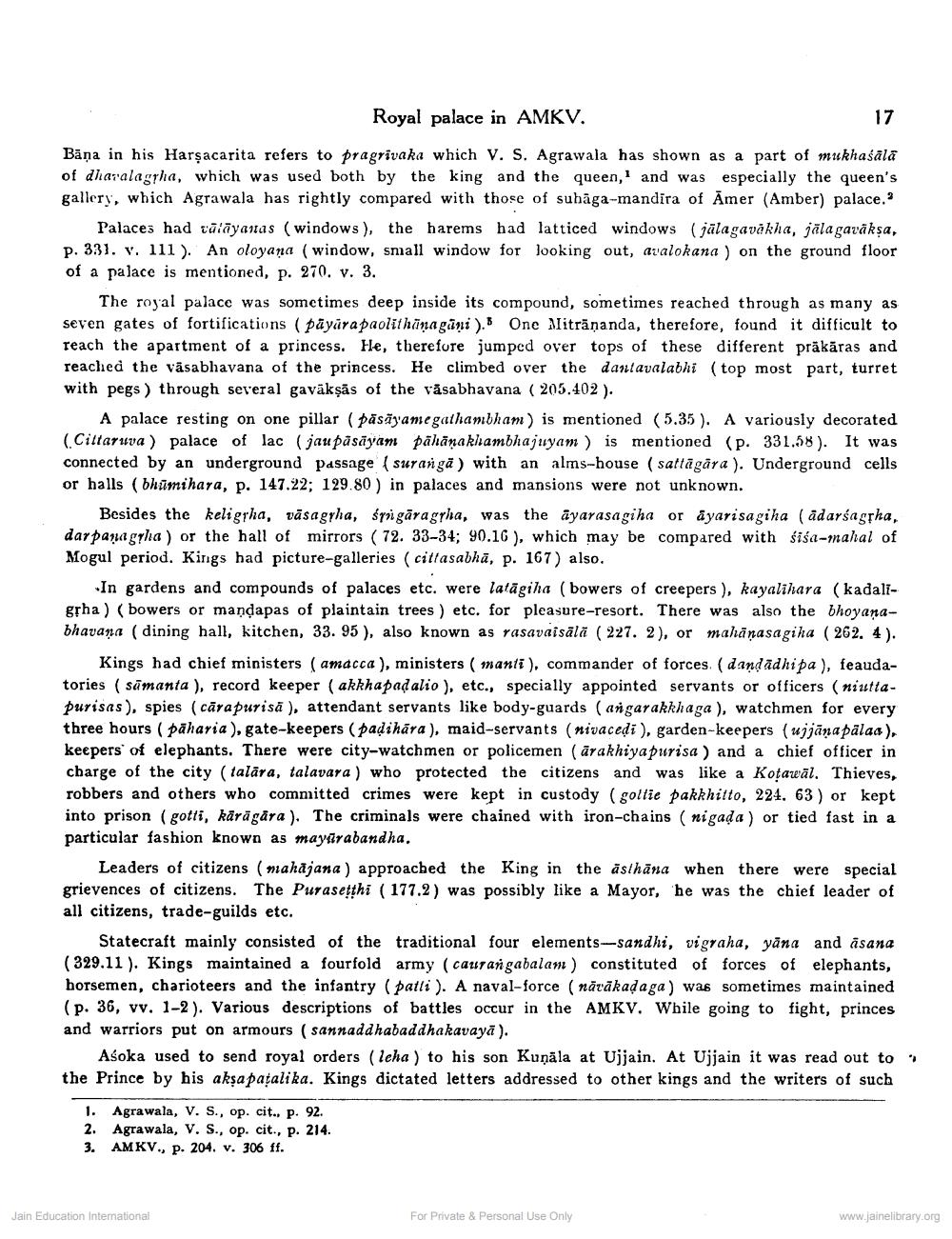________________
Royal palace in AMKV.
Bāņa in his Harṣacarita refers to pragrivaka which V. S. Agrawala has shown as a part of mukhaśālā of dharalagṛha, which was used both by the king and the queen, and was especially the queen's gallery, which Agrawala has rightly compared with those of suhaga-mandira of Amer (Amber) palace."
Palaces had tulayanas (windows), the harems had latticed windows (jālagavākha, jālagavākṣa, p. 331. v. 111). An oloyana (window, small window for looking out, avalokana) on the ground floor of a palace is mentioned, p. 270. v. 3.
The royal palace was sometimes deep inside its compound, sometimes reached through as many as seven gates of fortifications (pāyārapaolithāṇagāni). One Mitrānanda, therefore, found it difficult to reach the apartment of a princess. He, therefore jumped over tops of these different prākāras and reached the vasabhavana of the princess. He climbed over the dantavalabhi (top most part, turret with pegs) through several gavākṣās of the vasabhavana (205.402).
17
A palace resting on one pillar (pāsāyamegathambham) is mentioned (5.35). A variously decorated (Cillaruva) palace of lac (jaupāsāyam pāhāṇakhambhajuyam) is mentioned (p. 331.58). It was connected by an underground passage (suranga) with an alms-house (sattägara). Underground cells or halls (bhumihara, p. 147.22; 129.80) in palaces and mansions were not unknown.
Besides the keligrka, väsagrha, drugaragṛha, was the ayarasagiha or ayarisagiha (adarlagtha, darpanagṛha) or the hall of mirrors (72. 33-34; 90.16), which may be compared with sisa-mahal of Mogul period. Kings had picture-galleries (cillasabkā, p. 167) also.
In gardens and compounds of palaces etc. were latāgiha (bowers of creepers), kayalihara (kadaligṛha) (bowers or mandapas of plaintain trees) etc. for pleasure-resort. There was also the bhoyanabhavana (dining hall, kitchen, 33. 95), also known as rasavaisālā (227. 2), or mahānasagiha (262. 4).
Kings had chief ministers (amacca), ministers (manti), commander of forces. (daṇḍādhipa), feaudatories (sāmanta), record keeper (akkhapaḍalio), etc., specially appointed servants or officers (niuttapurisas), spies (cārapurisā), attendant servants like body-guards (angarakkhaga), watchmen for every three hours (paharia), gate-keepers (paḍihara), maid-servants (nivaceḍi), garden-keepers (ujjäna palaa), keepers of elephants. There were city-watchmen or policemen (ärakhiyapurisa) and a chief officer in charge of the city (talara, talavara) who protected the citizens and was like a Koṭawal. Thieves, robbers and others who committed crimes were kept in custody (gollie pakkhitto, 224. 63) or kept into prison (gotti, kārāgāra). The criminals were chained with iron-chains (nigada) or tied fast in a particular fashion known as may@rabandha.
Leaders of citizens (mahājana) approached the King in the asthana when there were special grievences of citizens. The Puraseṭthi (177.2) was possibly like a Mayor, he was the chief leader of all citizens, trade-guilds etc.
Statecraft mainly consisted of the traditional four elements-sandhi, vigraha, yana and asana (329.11). Kings maintained a fourfold army (caurangabalam) constituted of forces of elephants, horsemen, charioteers and the infantry (patti). A naval-force (nāvākaḍaga) was sometimes maintained (p. 36, vv. 1-2). Various descriptions of battles occur in the AMKV. While going to fight, princes and warriors put on armours (sannaddhabaddhakavayā).
Aśoka used to send royal orders (leha) to his son Kuņāla at Ujjain. At Ujjain it was read out to the Prince by his akṣapatalika. Kings dictated letters addressed to other kings and the writers of such
1. Agrawala, V. S., op. cit., p. 92.
2. Agrawala, V. S., op. cit., p. 214.
3. AMKV., p. 204. v. 306 ff.
Jain Education International
For Private & Personal Use Only
www.jainelibrary.org




